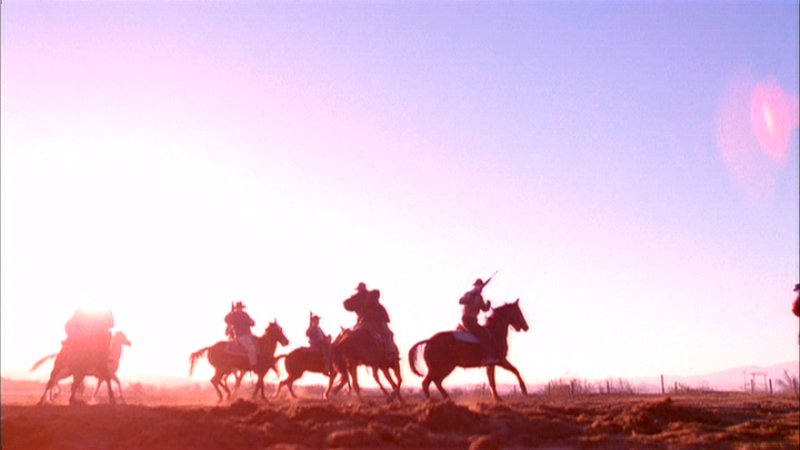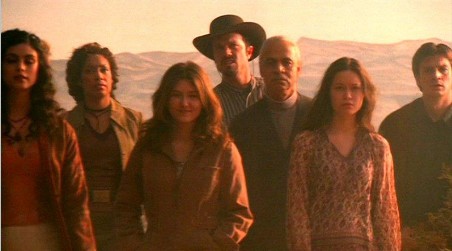

Structure and Significance:
Firefly, the Space Opera
Firefly has all of the qualifications of a successful space opera. It focuses on travel as the crew roams the galaxy, its major plot is based around the interaction of the characters with each other and external forces, and it is not so technical that it is outside of the viewer’s comprehension. An example of the series’ character-driven aspect is s its unusually large central cast of nine round characters. Furthermore, it identifies with newer themes of the space opera: extremes, emotions, cyberpunk, ancient settings, and environmental disasters.
Extremes and Emotions
Firefly address extremes of race by creating a futuristic world in which the China and the West are the only superpowers and by readdressing gender roles through the Washburne’s relationship and the respectable position of the Companions (For more information, please see Firefly and Sexual Roles). The emotional and sometimes over-dramatic appeal of the show is one of its securing factors, and firmly keeps viewers by creating characters which are believable and able to be identified with. Partly due to the fact that it’s a television show and partly due to the fact that it’s a space opera, each episode is loaded with emotions. To create emotional tension, decisions are never easy or singular sided. Instead, the characters regularly must undergo difficult decisions based on conflicting desires. For example, in “Out of Gas” Mal decided to risk suffocation rather than sacrifice one of his crew (“Firefly”).
Cyberpunk Influences
The cyber punk theme of rebellion against established authority (“Cyberpunk”) can be seen throughout the series. The basis of Firefly rests upon the rejection of and constant contestation by the Independents with centralized authority, the Alliance. (Firefly and Central Authority ) As accented by the character’s western slang, unpretentiously practical attitudes, and generally violent actions, Firefly continues the “gritty, hard-hitting” (“Cyberpunk”) style of cyberpunks. Additionally, many episodes such as “War Stories” in which Mal and Wash are tortured (“War Stories (Firefly episode)”) or the gruesome deaths showed in “Ariel” (“Ariel (Firefly Episode)”) have the darkness of cyberpunk. The cyberpunk effect of Firefly adds to its appeal, and can be identified with the increasing number of cyberpunk science fiction literature, television, and films such as William Gibson’s Burning Chrome (Barron 1006) or the Matrix trilogy (“Cyberpunk”). As a token to cyberpunks, one reoccurring character is a standard cyberpunk hero similar to Bobby in Burning Chrome (1006): Mr. Universe, a grungy techno-genius, controls people and goods through an extensive information computer system and even has a mechanical girlfriend (“Firefly”). Regardless of all of the similarities and borrowed elements, though, Firefly is not cyberpunk science fiction, because it is set in space and does not concern computers, cracking codes, or information-system subculture life (“Cyberpunk”).
Ancient Setting (American Western)
To contemporary Western culture caged in by barbed wire and machines, the old West of the 1800’s is an ancient setting. The longing for the old West could be seen as early as the 1860s, and through the 1900’s, Westerns became so well-liked that cheap Westerns featuring a “cool detached hero”, clear cut villains, and the predictably eventual triumph of good were sold for only ten cents (“Dime Westerns”). The romantic appeal of cowboys and their free, hard lifestyle has not faded out of contemporary American culture, which can be seen in the continuous popularity of Western television shows and films. Films such as The Good, the Bad, and the Ugly, Once Upon a Time in the West, and High Noon are all successful because they identify with the simplistic morality of a Western and oftentimes undermine it (“Western (genre)”). For example, the “good guy” in the white hat is a standard Western convention, but recently the films will add so many complications, negative yet justified actions, and character traits, that the viewer question the concept of a hero and if the hero can really be good (“Western (genre)”). Firefly continues this tradition, even though only a few of its episodes, such as “Serenity” or “The Train Job” have readily visual, Western identification such as saloons, horses, and trains [(“Serenity (Firefly episode)”) and (“The Train Job (Firefly Episode)”]. Many details in Firefly align with traditional Westerns in a more subtle manner, such as their non projectile guns being shaped like rifles and pistols, the presence of leather and brown coloringin their costumes, the American folk-like music, and the crew’s use of Western slang. The main hero, Mal, is often detached and has the no-nonsense Western mentality. However, in the spirit of recent Westerns, few stereotypes are cleanly portrayed and the difference between right and wrong is often ambiguous. For instance, some of the villains such as Adelei Niska are presented as evil, but others like the bounty hunter Jubal Early merely do violent actions as a job rather than from personal motivation (“Firefly (TV series)”).
Environmental Disasters
Environmental disasters are also present in Firefly to the extent that they are the basis for the television show. Although direct environmental activism or destruction based dystopias are not discussed, if humans had not used all of Earth’s resources the other planets would not have been colonized and the political tensions between the Independents and the Alliance would not have arisen. Terreforming does discuss how the other planets’ negative response to manipulation, but often this is simply to visually progress the Western theme. The idea of environmental destruction on Earth is so accepted that it does not have to be elaborated upon. This is one negative aspect of the series because an escapist theory of humans’ treatment of Earth’s environment is counterproductive and distracts viewers from the reality of environmental degradation.

The Significance of Firefly for Space Operas
Firefly is important to the space opera subgenre because it helps its progression. Although identifiable as a space opera by its above characteristics, the unique combination and expansion of these aspects challenge the traditional space opera. The appeal of Westerns have been present in space operas before, such as in C.L. Moore’s “Northwest Smith” series (Roberts 525) or Eric Russell’s Jay Score (587), but the visually obvious combination of the two genres is unique. Including both sets of codes and attractiveness will increasingly secure more interest in space operas because it appeals to fans of Westerns as well as science fiction. By being less technical and so more accessible to viewers and also by presenting science fiction ideas in a Western language which has been integral to American literature, entertainment, and identity since the 1880’s, space operas will be able to make a greater impact on more people.

Links
Last Modified 24 April 2006 Created by Julie Rooney julierooney_2009@depauw.edu
Contact me